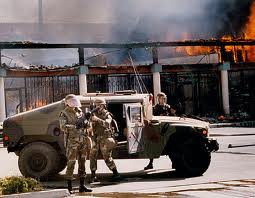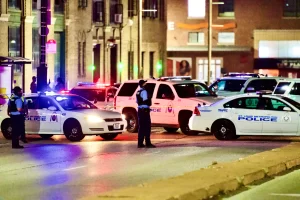 I am a survivor of the rebellions in Kansas City in 1968. While this piece was recorded last week, I could already see a familiar pattern in aggressive policing and decision-making by government authorities. Today, the Missouri National Guard was ordered to Ferguson by Governor Nixon. In Kansas City, 5 black people were killed after the Guard came in.
I am a survivor of the rebellions in Kansas City in 1968. While this piece was recorded last week, I could already see a familiar pattern in aggressive policing and decision-making by government authorities. Today, the Missouri National Guard was ordered to Ferguson by Governor Nixon. In Kansas City, 5 black people were killed after the Guard came in.
Listen here. The full text of my commentary is below:
Lately, I can’t help but reflect on a 1968 best-seller book that was widely read and discussed but brought about little change. The book was the infamous Kerner Report.
The book was the published report of the National Advisory Commission on Civil Disorders appointed by President Lyndon B. Johnson in 1967. The seven month study looked at the underlying causes of city uprisings from 1964-1967.
The report’s most famous warning has now come to pass: “Our nation is moving toward two societies, one black, one white—separate and unequal.” We can now add economic inequality to the equation as we witness the widest income wealth disparity ever in this nation. The result of the disparity is that nearly 45 million Americans live in poverty today, according to the U.S. Census Bureau.
The Kerner Report spotlighted failed housing, education and social service policies of the government on all levels-local, state and federal — as fiery fuel to the unrest. The report also took aim at the mainstream media. “The press has too long basked in a white world looking out of it … with white perspective.” The report clearly put racism and racial discrimination at the center of public policies and laws as well as the behavior and practices of those in authority.
Fast forward to 2014 where economic, political and social conditions have worsened. Not only has there been no attention paid to creating more opportunities for better housing, education and employment, we have actually experienced an intentional divestment in all three of these areas, which are the bedrock for ensuring viable families and stable communities.
The conditions cited more than 45 years ago are bubbling up across the nation once again. The incendiary situation that has been created by forces outside of black and brown communities has always been exacerbated by years of overly aggressive and hostile policing methods. It was the match that ignited the dynamite in Ferguson with the killing of Michael Brown, an unarmed, black teenager.
It’s easy to sit in the comfort of one’s home, watch selected images of the Ferguson situation and make judgments about the character, values and aspirations of the people on the television screen. As difficult as it may be, I urge spectators to put themselves in the shoes of a young black man in Ferguson, of young black men in America to understand their responses to be criminalized and marginalized by the society they live in.
Mike Brown did all the right things: He graduated from high school, he was scheduled to enter a tech college this fall to continue his education. When accosted by the police, he allegedly raised his hands in compliance. Yet Michael Brown is just as dead as a high school dropout who was involved in a deadly carjacking. This kind of policing approach is a growing stressor for black parents raising sons.
While the city of Ferguson boasts of its recognition as “Playful City USA,” maybe it’s time to stop playing and get to the root causes of the anger and frustrations of black youth and how we can systematically address them. A good place to start is the still-timely findings of the Kerner Report.



